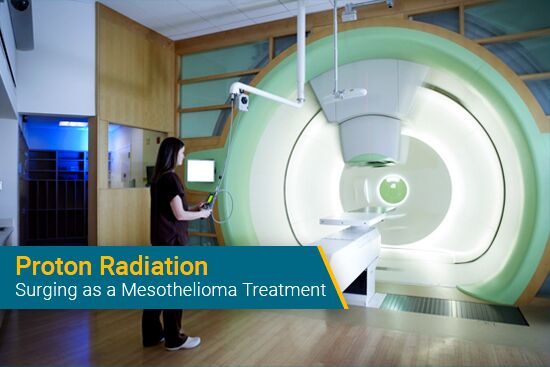Estimated Read Time: 3 minutes
Experts continue exploring new treatment options for mesothelioma patients. Some ideas aren’t brand new but are tweaks to current forms of care.
The recent rise of proton radiation therapy is one such example of the ever-evolving treatment for this rare yet aggressive cancer.
The New York Proton Center opened in early 2019, making it the 28th such medical institution in the United States. Twenty of them have opened since 2012, and four more are on their way.
How is proton radiation different from other types of radiotherapy? The answer is precisely why this care is so appealing, especially for treating tough-to-stop cancers like pleural mesothelioma.
What Is Proton Radiation Therapy?
Proton radiation therapy was created in the 1940s, but not until 1990 did the first hospital-based, treatment-dedicated institution open. That year is when Loma Linda University Cancer Center made history. Almost 30 years later, many other hospitals have made this treatment more accessible.
“While traditional photon radiation pierces through tumors, protons stop at the intended target, limiting irradiation of the surrounding tissue and organs and minimizing patient exposure to excess radiation,” a representative from the New York Proton Center said in an email exchange with Mesothelioma Guide.
Radiation is a low-invasive treatment for mesothelioma patients, and the side effects are often less than those of chemotherapy. However, the traditional photon radiation treatment does have risks: Irradiation attacking and killing healthy tissue is a risk for mesothelioma patients.
Proton therapy attacks the diseased cells and stops short of targeting healthy ones, which can increase a patient’s quality of life.
“Proton therapy spares mesothelioma patients the severity of side effects that traditionally result from photon radiation,” the representative said, adding the radiation also “allows proton oncologists to deliver stronger doses of radiation.”
The result? Patients receive productive treatment in a short amount of time.
(Photo courtesy the New York Proton Center)
Proton Radiation for Pleural Mesothelioma
Since proton therapy has few, if any, adverse effects, the treatment is an option for late-stage mesothelioma patients. Those with an advanced form of the cancer usually have limited options, which can be discouraging.
Proton therapy “is particularly effective in targeting difficult-to-treat tumors” because doctors can deliver a higher dose to the disease location. Pleural mesothelioma fits the classification of “difficult-to-treat” tumors, and the experts at the New York Proton Center have already treated a patient.
In a 2018 study, researchers found that proton therapy reduced the radiation dosage delivered to a patient’s at-risk organs. These body areas include the:
- Spinal cord
- Kidneys
- Lung
- Heart
- Liver
- Esophagus
These results suggest that mesothelioma patients who undergo proton therapy and not traditional radiation had a reduced risk of liver disease, kidney injury and acute esophagitis.
Traditional radiation also may require a treatment break due to the irradiation risk. The study found that proton therapy for mesothelioma does not require a pause. Therefore, doctors can stick to the treatment plan to address the tumors and prevent them from spreading.
What Does Proton Radiation Therapy Entail?
Most patients currently going to the New York Proton Center are from the northeast region of the United States. However, the center is accepting patients from throughout the country.
Each mesothelioma case is unique, which means a patient’s treatment is often unique as well. However, the center has a general schedule to provide a sense of what someone should expect from the treatment:
- The entire session (including preparation and post-radiation conversations) usually lasts one hour.
- Radiation itself lasts around 15 minutes.
- Most patients undergo four or five sessions per week.
- A proton radiation therapy plan can last anywhere from two to six weeks.
If attending the New York Proton Center is not feasible for you or your loved one with mesothelioma, then there are other proton centers in each region of the country. We at Mesothelioma Guide can help you find a center that treats mesothelioma and is conveniently located to reduce your travel and other hardships.
Email our patient advocate and registered nurse, Karen Ritter, at karen@mesotheliomaguide.com to find out which center is your best option.
Sources & Author
About the Writer, Devin Golden
Devin Golden is the senior content writer for Mesothelioma Guide. He produces mesothelioma-related content on various mediums, including the Mesothelioma Guide website and social media channels. Devin's objective is to translate complex information regarding mesothelioma into informative, easily absorbable content to help patients and their loved ones.
Sources & Author
About the Writer, Devin Golden
Devin Golden is a content writer for Mesothelioma Guide. He produces mesothelioma-related content on various mediums, including the Mesothelioma Guide website and social media channels. Devin's objective is to translate complex information regarding mesothelioma into informative, easily absorbable content to help patients and their loved ones.
